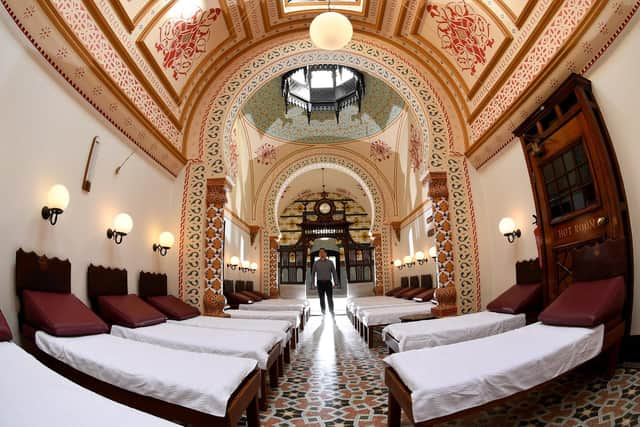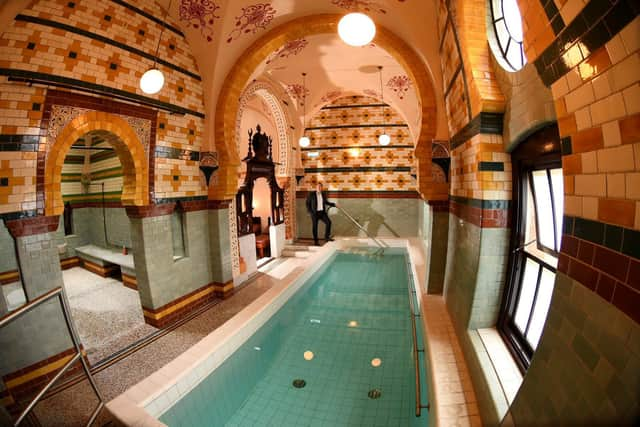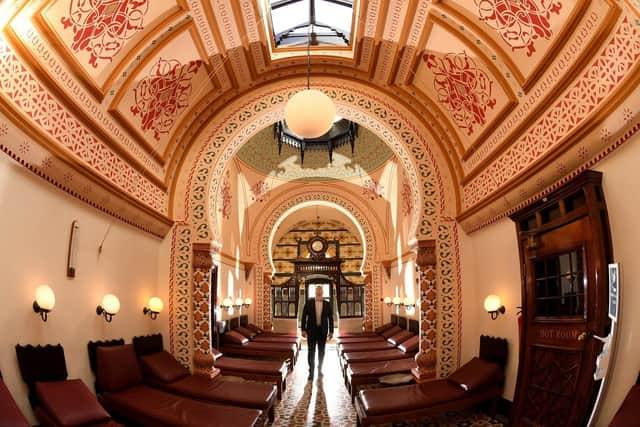Harrogate Turkish Baths at 125: The Victorian spa with a fascinating history of royalty, Agatha Christie and bizarre treatments
Among the facilities within what was one of the most advanced hydrotherapy centres of its age - and a ‘one-stop shop’ for treating a variety of Victorian ailments - were the Turkish Baths, and few would have predicted that 125 years later, the ‘hammam’ would be the complex’s only survivor in its original form.
Managers took a gamble in 1969, when changing times led to the Royal Baths’ closure and conversion into a number of other uses, and they decided to preserve the Turkish Baths as they had been when Queen Victoria’s granddaughters, Cabinet ministers, foreign royalty and author Agatha Christie enjoyed their unusual therapies.
Advertisement
Hide AdAdvertisement
Hide AdSince then, what was once an exclusive enclave for the wealthy visitors who spent the season in Harrogate has become more affordable and accessible, while retaining its period features and atmosphere.


“The Royal Baths were a leading treatment centre at the time, with mud baths, steam rooms, peat baths and doctors attached to the White Hart Hospital. The Turkish Baths have stood the test of time. Victorians were very taken with eastern relaxation methods and they had a more refined slant. Visitors were very well attended-to and they are today in the same way as when they opened,” said Chris Mason, who manages the Harrogate Council-owned building.
Tough times came in 1914, when war saw the number of well-to-do patrons decline and hydros fall out of favour. As public health improved, convalescent travel was less commonplace.
Harrogate’s baths did manage to remain profitable in the inter-war period, but by 1969, when the axe fell, the treatments and technology they offered had become outdated and demand had dropped significantly. The impressive Royal Baths building was split into several units, but the Turkish Baths were deemed to be viable and allowed to remain - albeit with a focus more on massages than increasingly questionable electrotherapy treatments.


Advertisement
Hide AdAdvertisement
Hide Ad“The 1970s and 80s were challenging as there was the boom in foreign travel, and money dried up for a lot of these baths. We always retained local custom and continued to renovate and refurbish. People still come now to relax in the same way they did in the 1800s, but we have become more visible and have repositioned ourselves.”
Harrogate is the best-preserved survivor from the golden era of the health spa, and there are only two other similar 'hammams' remaining in England.
Although the heating now has a more environmentally-friendly electric source, the Victorian engineering system is still in use. A chimney cascades heat around the building, and the glazed bricks and high ceilings retain it.
“The internals are unchanged and intact. We are custodians of this building and we use niche companies for restorations to the mosaics and marble floors. When we redecorate, we use old images as reference points. We are looking to re-expose hidden features, such as the vaulted ceilings in the lobby and hammam we revealed in 2018 which had been boxed in.”


Advertisement
Hide AdAdvertisement
Hide AdIn future, managers would like to expand the Turkish Baths’ footprint - a reversal of what happened in 1969, when the spa facilities contracted and other businesses moved in.
Opening hours that run into evening sessions restrict the building’s potential use as an events space, but private hire is popular and the breadth of activities could eventually extend to alternative therapies and mindfulness classes.
“It’s history in a modern setting and we need to keep it open and cater for anybody. Buildings like this fall apart if you don’t.”
Comment Guidelines
National World encourages reader discussion on our stories. User feedback, insights and back-and-forth exchanges add a rich layer of context to reporting. Please review our Community Guidelines before commenting.

